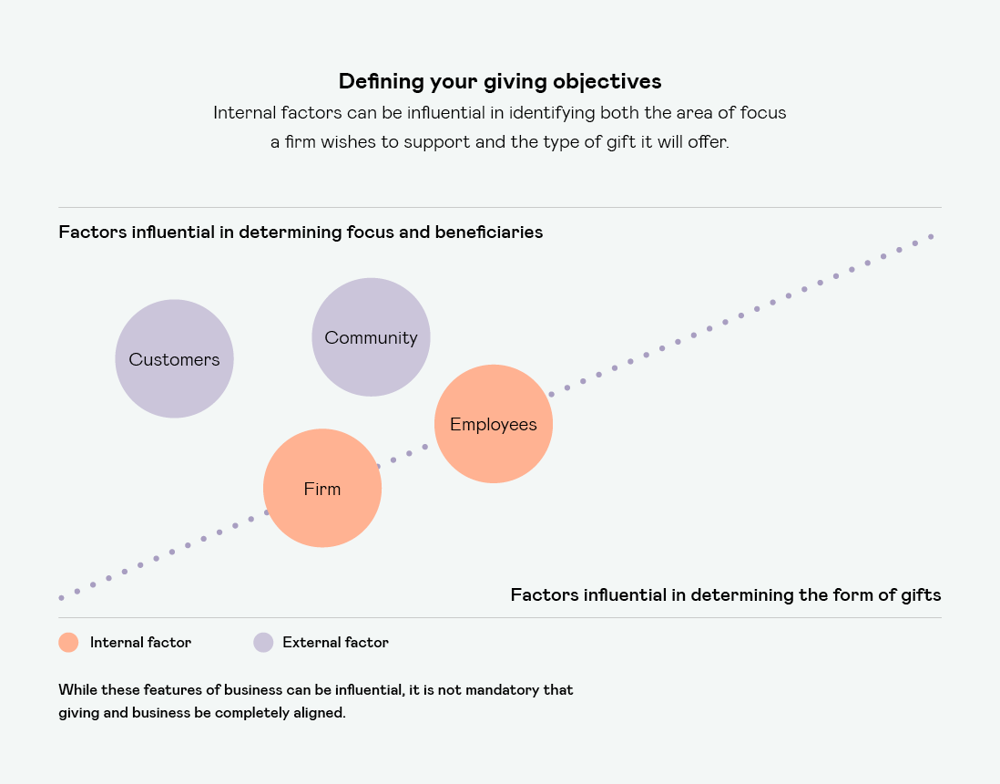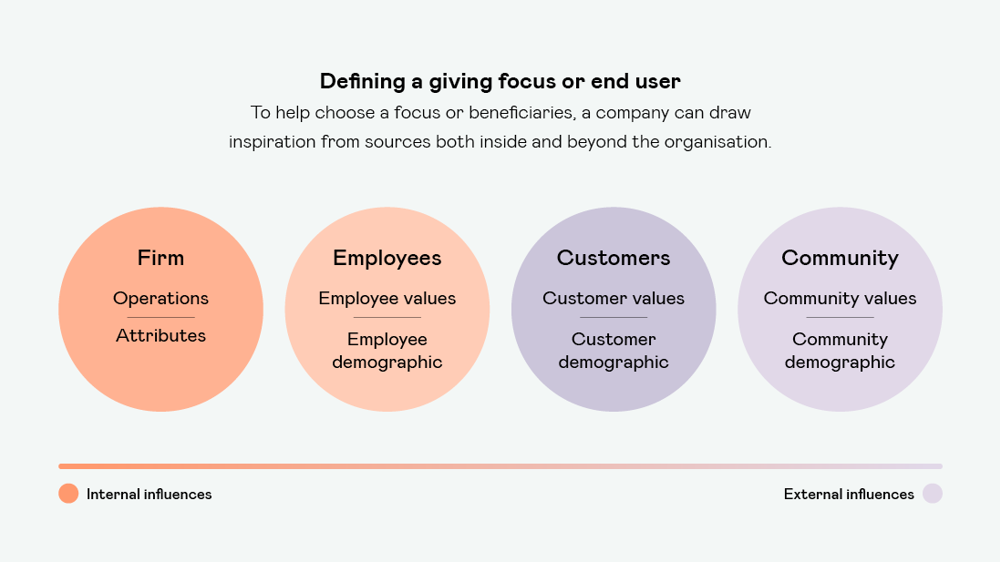Introduction
- Giving objectives define what you plan to give and to whom. These can be supplemented by a theory of change, if one is relevant to your giving.
- Your operations define where your giving will be conducted and the mode you wish to use to make those gifts. This guide will focus on your giving objectives.
With respect to defining giving objectives, the possibilities are virtually unlimited. Setting your focus on specific issue areas, geographies, institutions, or even populations presents a wide range of options.
With respect to the form your gift will take, other assets such as time, expertise and tangible goods may also be available. If so, your corporate philanthropy can incorporate more than just financial gifts.

While the final choice of what to give and to whom rests with your decision-makers, your organisation can narrow down its options by drawing inspiration from sources inside and beyond the firm.
Factors that can influence how a firm defines its giving objectives include:
- Internal factors: the firm itself and the employees.
- External factors: the customer base and the community.
A discussion around corporate philanthropy and the ecosystem of factors that influence it can be easily misconstrued as one about corporate social responsibility (CSR). It is important to note that CSR and corporate philanthropy are neither the same in concept nor in execution. While corporate philanthropy and CSR can be considered part of a unified strategy, corporate giving is independent from a firm’s mandatory and ethical business practices.
Fundamentals
A critical early step in setting a giving strategy is to determine the two parameters that define the framework of your giving objectives.
- Beneficiaries or giving focus. This establishes the ‘end user’ of your philanthropy.
- Form of gift offered. This establishes the resource transferred through giving.
To set each parameter, a firm can seek guidance from a set of internal and external sources of influence. Internal factors, such as a firm’s characteristics and employees, can be influential in identifying both the focus and the form of gifts. External factors including customers and community can bear heavily on defining focus, but are not as helpful in determining the types of gifts that can be transferred. Both groupings are explored more deeply below.

Giving parameter: focus and beneficiaries
Defining the focus or beneficiaries of corporate giving is essential in helping a firm ration its resources and signal its areas of interest to grant seekers. Having a defined focus or end user makes corporate philanthropy feel more ‘concrete’, which then builds internal momentum and commitment.
Seeking direction from the firm’s unique characteristics, or from among employees, customers, and community, can help to narrow the immense field of possibilities.

Looking internally at a firm’s operations and attributes – its mission, vision, and values – can supply clues as to what is of interest and importance to a firm and by extension, its giving.
- Operations
Causes that are related to business operations are a natural place to anchor giving focus. While offsetting the effects of commercial operations is a responsibility, supporting related causes can be considered to be philanthropic. For example, food manufacturers might offset deforestation caused by mass-farming via their CSR strategy, but they could direct their philanthropy to nutrition-related social causes such as food security and food banks. Similarly, courier services might offset their transport emissions via a CSR strategy involving carbon credits, but could also direct giving to support the development of electric vehicles and drone technology.
From the field: Patagonia Inc
Patagonia is a global outdoor sportswear and equipment brand. Patagonia’s niche in the specialty outdoor market guides its corporate philanthropy, which is firmly centred upon environmental protection. Since 1985 Patagonia has operated the ‘1% for the Planet’ campaign through which it gives one percent of its total sales revenue to causes related to environmental protection.
- Attributes
A firm’s mission, vision, and values can also help steer the focus of its corporate philanthropy. These attributes clarify what an organisation holds dear and paints a picture of what it hopes the future will bring; two elements that can be strengthened by a giving strategy. For example, a healthcare firm likely values all human life and could find utility in supporting causes that drive social equality. An automobile manufacturer may espouse a corporate vision for a world that no longer relies on fossil fuels. It could then drive its giving towards developing sources of renewable energy.
From the field: Coca-Cola Company
The Coca-Cola Company’s vision is to: “craft the brands and choice of drinks that people love, to refresh them in body and spirit,” done in ways “that create a more sustainable business and better shared future that makes a difference in people’s lives, communities and our planet.” In keeping with this vision for impact and a better shared future, the Coca-Cola Foundation has given more than $1bn in grants to support female empowerment, environmental protection, and community enhancement.
Influence 2: employees
Directing corporate giving towards areas that are of interest, importance, or are relatable to employees is a powerful way to drive firm-wide engagement in philanthropy and can be an effective means of bolstering retention.
- Employee values
Individual philanthropy is on the rise. Employees are likely already giving to, fundraising for, and volunteering with causes and groups that are important to them. Offering donation matching schemes or automatic payroll donations to employee-identified organisations are two simple ways that corporate philanthropy can take inspiration from employee values.
From the field: Google
Google supports employee donations to their chosen charities by matching individual gifts of up to $6,000 per employee. In 2017, Google and its employees gave $97m to employee-selected community organisations.
- Employee demographics
If an organisation has a somewhat uniform workforce – for example an employee base dominated by women, scientists or working mothers – it can consider giving to causes and organisations that reflect that demographic.
From the field: Avon
The cosmetics giant Avon has a global workforce that is nearly 60 percent female so its corporate foundation directs giving to reflect the dominant employee demographic. To date, the Avon Foundation has given over $1bn to female-centric causes.
Influence 3: customers
For B2C organisations that engage directly with consumers, focusing corporate giving in areas that are of interest, importance, or are relatable to the customer base is an effective means of bolstering brand awareness and consumer loyalty.
- Customer values
Niche businesses may have an easier time of identifying what customers value, but it is still possible for organisations with a wider customer base to identify areas of interest. For example, many clients of bookstores are interested in spreading knowledge. But clients of large retail hypermarkets may have much more varied values. Donating a portion of sales or profits to a charity of their choice or offering a choice amongst a small pre-determined selection of organisations could be effective in aligning with customer values.
From the field: Amazon
E-commerce platform Amazon offers customers a unique opportunity to direct its corporate giving. Through its dedicated website www.smile.amazon. com, Amazon donates 0.5 percent of the sales price of eligible purchases to a charity of the customer’s choosing. More than one million charities are registered with the programme.
- Customer demographic
If an organisation has a uniform customer base, for example a toy company focused on youth or a cosmetics company selling primarily to female customers, a firm might consider giving to causes and organisations reflecting that particular demographic.
From the field: Nintendo
Nintendo, the global manufacturer of electronic gaming consoles, is popular among young consumers. The company channels its corporate giving to a broad range of organisations that have one thing in common – they support youth issues. Nintendo’s corporate giving supports after school programmes, early learning centres, paediatric care centres, and more.
Influence 4: community
Private sector firms are an important pillar of the communities in which they operate. Communities, however, are diverse and a firm seeking direction can find itself pulled in multiple directions. Regardless, making an effort to zero-in on shared areas of interest, or learning about and meeting community needs, can be an effective means of strengthening the public-private bond.
- Community values
Communities are diverse in terms of what they value, but firms can actively direct their giving based on broad surveys to understand areas of common interest. In the age of social media and crowdsourcing, firms can easily learn about the issues a community cares about and the organisations it supports.
From the field: State Farm Insurance
State Farm is a leading insurance provider in the United States. The firm enlisted the help of the community to determine the causes that would receive $5m in grants from the company. During its aptly named ‘Cause and Effect’ campaign hosted on Facebook, community members nominated more than 3,000 ‘causes’ for the grants, far exceeding the initial goal of 500 submissions.
- Community needs
Community organisations are a reliable source of information and can shed light on needs that exist locally. Encouraging them to be candid and open about shortages, or to self-identify resource gaps, can help to direct funding to areas that will be immediately impactful.
From the field: Walmart
US-based retail giant Walmart is committed to serving the needs of its hometown community of Bentonville Arkansas. To understand and satisfy a broad range of needs, Walmart operates an ‘open’ grants process for local nonprofits. This process allows community organisations to self-identify as beneficiaries and to submit up to 25 proposals each year for direct cash support.
Giving parameter: form of gift
Financial gifts dominate in corporate philanthropy and for good reason. However, corporate giving can take many forms. Many organisations have access to tangible and intangible non-financial assets that can create impact. A firm may wish to look internally at its own lines of business and employees to find guidance on the types of gifts it can make. Internal factors are more relevant in this area because external factors do not always have a clear or reasonable understanding of corporate resources.
Influence 1: the firm
Looking internally at a firm’s operations and attributes can supply clues about what is of interest and importance to a firm and by extension, its giving.
- Operations
Causes that are related to business operations are a natural place to anchor giving focus. While offsetting the effects of commercial operations is a responsibility, supporting related causes can be considered to be philanthropic.
From the field: Salesforce
Salesforce offers a leading suite of cloud-based CRM software. Through its ‘Power of Us’ programme, the firm offers nonprofit organisations free subscription packages to help manage their operations. More than 39,000 community organisations worldwide have accessed Salesforce’s technology through this scheme.
- Non-core assets
Giving away the products and services a firm produces is not the only way to utilise its non-financial resources for philanthropy. Take, for example, when firms rotate IT equipment or renovate office spaces. Their used laptops can be refurbished and offered to underserved students and furniture can be installed in youth centres. Transferring functional, in-demand physical assets is a wonderful way to carry out philanthropy and spare landfills at the same time.
From the field: Skyscanner
Skyscanner, the UK-based e-commerce travel aggregator, donated laptops, monitors and other IT equipment to schools in Malawi through its partnership with the Turing Trust. By donating its equipment, Skyscanner not only supported schools in need but also reduced its environmental footprint.
Influence 2: employees
In today’s knowledge economy, employee skills and man hours are arguably a firm’s most valuable assets. Pairing skilled employees that have an interest in volunteering, together with nonprofits that struggle to afford professional services, training, and staff, makes for impactful philanthropy. Providing employees an opportunity to work with nonprofits can also strengthen retention and overall pride in the workplace.
- Skills and competencies
Some nonprofit organisations rely heavily on pro-bono services to support their operations. Legal support, translation, consulting services, data collection and other such services are vital to their work, but often outside of their budgets. Firms that offer these services commercially can gift them pro bono to nonprofits. In addition, training and support in areas such as fiscal management, data analytics and other competencies could be offered. There are several intermediaries such as the Global Pro Bono Network that can help pair service providers with nonprofit organisations in need.
From the field: McKinsey & Company
McKinsey & Company is a global consulting firm with staff in more than 65 countries. Through its pro-bono initiative, the firm employs its knowledge and problem-solving approach to support hundreds of nonprofit organisations each year to realise their full potential.
- Volunteerism
Volunteerism can take many forms, from manual labour to serving on a board. Younger employees often cite the availability of volunteer opportunities as a key attraction when selecting an employer. Aside from a volunteerism policy, a firm could support further volunteerism by matching volunteer hours with cash grants to the organisations where employees dedicate their time.
From the field: Microsoft Corporation
Microsoft and its family of technology subsidiaries match employee donations but also go a step further to encourage employee volunteerism by offering hour- for-hour matched grants. The company grants $25 for each volunteer hour committed by its employees to a nonprofit of their choice. In 2019, more than 77 percent of its employees took part by committing 825,000 hours across 23,000 different organisations.
